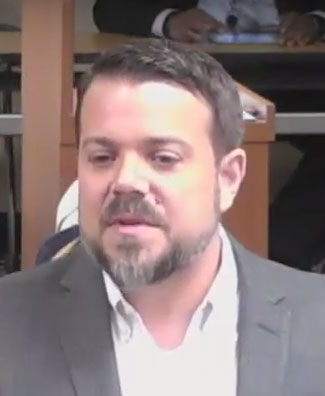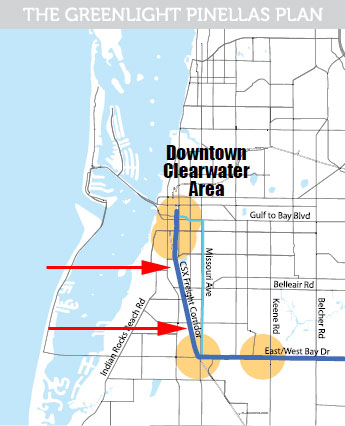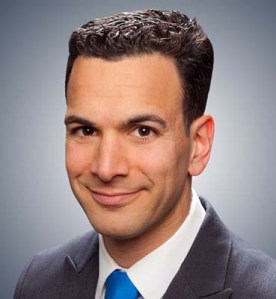At today’s monthly PSTA board meeting, a flawed resolution that was “approved in form” by its top attorney was before the board for approval. The flawed resolution passed unanimously, as written. As explained below, there are also signs that efforts are underway to inpose light rail against the clearly and repeatedly stated will of the voters.
The one-page resolution began with a “whereas” recital, a common term in legal documents. In this context, the term “whereas” literally means “given the fact that” (or alternatively “in view of the fact that.”) The whereas correctly and factually found that PSTA “has the authority to file and execute the Transportation Disadvantaged Mobility Enhancement grant application.”

However, the resolution then decided (“resolved”) what it had just declared to be true. A good analogy would be the board finding that since it is in fact a transit agency, therefore it resolves (decides) that it is a transit agency.
At least the resolution didn’t commit the rhetorical sin of tautology, which is saying the same thing twice in different words. Rhetorical tautologies are generally considered to be a fault of style, and we shall have occasion to mention tautologies later in this article.
A public agency’s top attorney is called its general counsel. PSTA’s general counsel is Alan Zimmet, whose firm Bryant Miller Olive enjoys a five year contract with PSTA worth as much as $1.75 million for providing legal services to PSTA. That’s just short of $30,000 per month.
Zimmet has a reputation as an attorney who knows the law very well. Zimmet recently won a Florida Supreme Court case in which he defended the City of Largo in a lawsuit involving low-income housing (a.k.a. “affordable housing”).
However, today’s flawed resolution may indicate that Zimmet has lost a step. Or alternatively: Zimmet may simply not care to protect the board from embarrassment anymore . Not after the board disregarded his legally sound instructions at its February meeting.
The fact that board passed today’s flawed resolution unanimously also suggests that no one on the board actually read it. Or alternatively: board members also simply do not care. No one pays attention to what local transit agencies do, right?

If that was it, this article would end here and be viewed by most readers as persnickety. However, there were other signs at today’s meeting of deeper problems at PSTA, and a more general problem with corruption of the public policy process. What is worse, another effort to impose light rail on the taxpayers of the Tampa Bay region is clearly under way.
Today’s flawed resolution to pursue a federal grant application wasn’t the only embarrassment of the day. The meeting agenda said that “staff will provide an update” on a “Regional Premium Transit Study.” Instead of staff providing the update, the speaker was Scott Pringle of Jacobs Engineering. Members of the public who may have wanted to hear or protest Pringle’s presentation were thus successfully kept in the dark by PSTA staff.
Also, the “Regional Premium Transit Study” has now somehow transformed itself from a “study” into a “plan”, specifically a “Regional Transit Feasibility Plan.” This “plan” has been arrived at before any public input has been sought.
It was Hillsborough County grassroots activist Sharon Calvert who first pointed out this furtive shift from conducting “a study” to developing “a plan.” Last month, Calvert also pointed out that Jacobs Engineering in applying to perform the “study/plan” incredibly claimed that “Tampa Bay residents do not understand the value of premium transit enough to pay for it.” In others words: the voters are stupid.
This is not the first time that Pringle and Jacobs Engineering are involved in thwarting the will of the people by corrupting the public policy process. It’s not even their first rodeo in Pinellas County. During the failed Greenlight Pinellas effort, Pringle was told by a senior CSX official in a letter dated 2/20/2012 that “Light rail is not compatible with freight rail. In other words, an electrified light rail system cannot operate on our [CSX’s] existing rail infrastructure in Pinellas County.”

Despite this clear statement from CSX, Jacobs issued a 216-page Engineering Technical Memorandum eight months later which spoke of the possibility of “obtaining shared use agreement” with CSX. They did so even though no such possibility existed.
The memo also said that “construction in CSX corridor may lessen environmental and traffic impacts,” even though there was no possibility of construction “in” or along CSX’s tracks. Most seriously, the memo also falsely spoke of “the unknown feasibility of using the existing CSX rail line” (see page 42).
Nothing was “unknown” about the feasibility – it was exactly zero. Yet PSTA printed up tens of thousands of informational brochures with a drawing showing the light rail route running in the “CSX corridor.” PSTA staff and elected officials also heavily messaged this “CSX corridor” fiction to the media, the public and others through other means.
Pringle was the Project Manager for Greenlight Pinellas at Jacobs Engineering and thus certainly approved the memo containing the misleading statements. The memo was a key part of the federally required Alternatives Analysis (AA) process which in this case cost Pinellas taxpayers $4 million. The AA is required prior to the issuance of any federal grants for transit.

Pringle turned what should have been a taxpayer-funded fact finding effort into a search for “alternative” facts. Instead of issuing a technical memo, he issued a “fake memo” (to coin a phrase) which spoke of a fictional “CSX corridor” that was never available to PSTA. This lying game was paid for by Pinellas taxpayers.
Pringle holds a Bachelor of Arts degree in “Environmental Planning and Design,” a non-engineering degree which apparently qualified him to supervise the production of an Engineering Technical Memorandum. More importantly, Pringle covered up the fact that light rail in Pinellas County would never run on CSX tracks, or in any “corridor” belonging to CSX.
Jacobs Engineering was not alone in conflating “study” and “plan” at today’s meeting. PSTA staff is apparently having a hard time distinguishing between the two, despite their best efforts. PSTA’s own agenda item description, ironically prepared by PSTA Planning Manager Heather Sobush, made no mention that a “plan” was being presented today. The word “plan” was simply not used in describing what was going to be presented to the board today.
Yet that very same agenda item document that speaks about a “study” (not a plan) was named “Regional_Transit_Feasibility_Plan_Summary.pdf”. We have highlighted the word “plan” in red for ease of reading.
While the Florida Legislature funds the study/plan and keeps Jacobs Engineering supplied with income in the absence of actual construction projects, PSTA has a $1.5 million “General Services Contract” with Parson Brinckerhoff. Parsons is a multinational engineering and design firm with approximately 14,000 employees and partnered with rival firm Bechtel to lead the highly troubled $22 billion “Big Dig” project in Boston.

Parsons was also selected by Hillsborough County to pave the way for the highly controversial Go Hillsborough “plan.” Channel 10 News reporter Noah Pransky ran over a dozen news stories about the corrupt Go Hillsborough effort before the Hillsborough county commission declined to place it on the ballot.
The commission voted twice on this issue and twice the vote was 4-3 against placing it on the ballot. There was no legal requirement to vote twice, rather it was a reflection of the tremendous pressure by moneyed interests.
Another Jacobs Engineering employee, Brandi Miklus, also had a questionable role in the Go Hillsborough effort, sitting at the sign-in table at county-organized “public engagement meetings.” Miklus is not a county employee.
Of greater concern is that Miklus was also one of the four founders of a fake grassroots non-profit organization called Connect Tampa Bay. The group’s funding (tax dollars laundered through another non-profit?) was never disclosed. Connect Tampa Bay had to dissolve itself after the Guardian found that they never filed required federal tax returns from the day they were created.
 The picture is quite clear: the lessons of Moving Hillsborough Forward (2010), Greenlight Pinellas (2014) and Go Hillsborough (2016) are being ignored. The same firms, even the same employees of those firms, that corrupted the public policy process previously in favor of light rail are now being used again. Why?
The picture is quite clear: the lessons of Moving Hillsborough Forward (2010), Greenlight Pinellas (2014) and Go Hillsborough (2016) are being ignored. The same firms, even the same employees of those firms, that corrupted the public policy process previously in favor of light rail are now being used again. Why?
Two months ago, independent left-leaning Tampa journalist Jim Bleyer asked rhetorically “Is anybody listening” in a headline. His article referenced those three expensive and failed efforts to impose rail transit somewhere in the Tampa Bay region, in every case against the clear will of the voters.
Last week, Bleyer said “the Tampa Bay rail cartel is back,” a concern that tea party grassroots activist Sharon Calvert has also expressed. Bleyer added that the rail cartel has “media accomplices.” Today’s event and recent media coverage suggests that Bleyer and Calvert are correct in their analysis. The Guardian is clearly late to their party.
The present “Plan / Study” fan dance involving the same discredited companies indicates that elected officials and the bureaucrats they fail to supervise are determined to answer Bleyer’s headline question with “no, because there shall be light rail. Because light rail. Just because, so just stop saying no to it.”
The word “tautology” has a rhetorical meaning, which was discussed earlier. But it also has a logical (mathematical) meaning. In pure logic, a tautology is a formula that is “true in every possible interpretation.” For example: “A or not A”, a formula which is always true.
The “Tampa Bay Transit Tautological Choice” is apparently even simpler than that. It goes like this: “voters may chose light rail or light rail.” At least the corrupt politicians will let the people decide which they prefer. Then again, we may not even get to make that decision if state senator Jack Latvala (R – Clearwater) has his way. That, however, is a whole ‘nother story.
As always, the Guardian reports and the readers decide. Please like our Facebook page to find out when we publish our articles.



